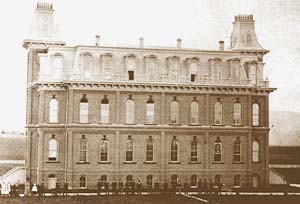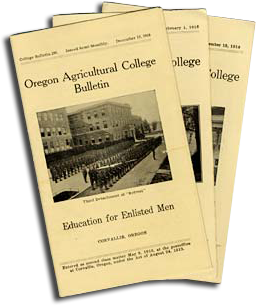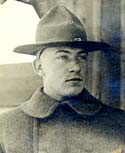The Corps Comes to Oregon
With the rapid expansion of the American Expeditionary Force in Europe, the U.S. War Department needed large numbers of officers and technical experts. To meet this need, it turned to college campuses across the nation with the Students Army Training Corps (SATC) program. The colleges possessed the settings, equipment, and organization to train large numbers of students for military service. In Oregon, both the University of Oregon in Eugene and the Oregon Agricultural College (OAC - the precursor to Oregon State University) in Corvallis met the requirements of the War Department for participation.
Young men who had not been drafted could apply to one of two tracks of study if they met the following requirements:
-
Section A: Men at least 18 years old who had completed a grammar school education. These men studied trade and technical subjects analogous to college vocational courses. Essay written circa 1919 on vocational education in Oregon during World War I.
(PDF)
- Section B: Men at least 18 years old who had completed a standard high school course of study. They could study either standard college courses or special war courses in engineering, mining, chemistry, physics, bacteriology, sanitation, and others.
At the Corvallis campus the new SATC military unit started in October 1917. To boost the coordination and efficiency of the effort, the SATC absorbed several existing programs, including the Cadet Regiment, Reserve Officers' Training Corps, Quartermaster's Enlisted Reserve Corps, and the Engineers' Enlisted Reserve Corps.
Accommodating the Corps
Once students were inducted into the corps, they were outfitted with uniforms consisting of one overcoat, one service hat, two cotton coats, two pairs of cotton breeches, one pair of leggings, one pair of shoes, one waist belt, and one collar ornament. While students had to pay for their own books, they did receive the usual soldier's pay of $30 per month as well as free tuition. And, they were entitled to free room and board.
The colleges had to scramble to meet the housing and "mess" needs of students. Oregon Agricultural College anticipated an enrollment of 2,000 corps students in the fall of 1918 and the University of Oregon saw 800 inductees drilling on campus. OAC hurried to erect a large barrack hall as well as a YMCA hall. Officials prepared to take further steps as needed, including requisitioning other college buildings, club houses, or private buildings:
Similarly, at the University of Oregon all fraternity houses on campus, the men's residence hall, Friendly Hall, and both the men's and women's gymnasiums were taken over by the government as temporary barracks for the SATC students as well as those in the related Officers Training Corps (OTC). At the same time, a company, which included Eugene businessmen as primary stockholders, was busy building building barracks nearby for the students. These would free up some fraternities and both gymnasiums for their normal use.
From Reveille to Taps
 Deady Hall, University of Oregon campus, continued to house classrooms during World War I. However, other buildings on campus saw duty as barracks for the military program students. (Photo courtesy Salem Public Library)
Deady Hall, University of Oregon campus, continued to house classrooms during World War I. However, other buildings on campus saw duty as barracks for the military program students. (Photo courtesy Salem Public Library)
The sound of bugles became a regular part of campus life with the introduction of the SATC to the universities. They sounded for both the SATC and the Officers Training Corps on the University of Oregon campus. Regular drills and other military training mixed with class work for the students. Uniforms were optional for the SATC students but those in the Officers Training Corps were required to wear their regulation khakis.
Besides the sounds of bugles and drill calls, the previously quiet campus was jolted by other noises since it served double duty as training ground for battlefield tactics. The OTC students would light up the sky during "the occasional all night battle in the trenches with plenty of rockets and exploding of blank cartridges and 'bombs' and constantly playing searchlights picking out the scouting parties of either side, to make the battle realistic."
The Watchful Eye
 OAC issued bulletins to help students navigate
available government programs during and after the war.
Subjects included SATC and classes for women in the college. (OSA, Oregon Defense Council Records, Publications and Ephemera, Box 8, Folder 4)
OAC issued bulletins to help students navigate
available government programs during and after the war.
Subjects included SATC and classes for women in the college. (OSA, Oregon Defense Council Records, Publications and Ephemera, Box 8, Folder 4)
Military regulations trumped university rules on the Eugene campus. SATC students could not leave their "cantonment" or temporary military quarters without a pass issued by an officer. Routine endeavors such as a trip to the library took on a military flavor as a University of Oregon news bulletin entitled "Oregon Overseas" wryly observed: "Even the studying of the men in the library in the evenings is under the watchful eye of a corporal or sergeant. The men are marched to the library from their barracks in companies, eyes front, and do their studying during specific study hours."
Other university rules felt the effect of the military presence and socially active students bore the brunt of the restrictions. "Oregon Overseas" described that "among the changes are the limiting of week night 'dates' of sophomore, junior and senior women living in the houses of residence on the campus to one only. No more may upper class women have as many 'dates' as they wish on week nights." The new rules also did away with house dances at sorority houses and women's residence halls.
"When Summoned to Service..."
While the course of the war looked promising to American military planners in the summer of 1918, they nonetheless had to prepare for the long haul. Therefore, they intended to increase the army by two million men by July 1919, which probably would necessitate the mobilization of all able bodied registrants under the age of 21 by that time. As a result, Oregon Agricultural College officials cautioned students that "it cannot now be definitely stated how long a particular student will remain at college." The life of the student was very much in the hands of the military. Except for those engaged in technical studies of military value such as medicine, engineering, and chemistry, SATC students were not "in any sense a deferred or favored class."
 Austin Case of Klamath Falls joined the SATC in Corvallis. He was discharged before seeing service in Europe. (OSA)
Austin Case of Klamath Falls joined the SATC in Corvallis. He was discharged before seeing service in Europe. (OSA)
Periodically the men in the Section B college track program were to be sorted and reassigned as military needs demanded according to their preferences and qualifications. This process must have had a "clarifying" and motivating effect on the intensity of their studies. Most fell into one of the following assignments:
- transfer to central officers training camp
- transfer to non-commissioned officers training school
- continued study at school for a limited time in a specified discipline
- assignment to vocational training school for technical training of military value
- transfer to cantonment for duty with troops as a private
Men in the Section A vocational program also had incentives. They were to be "rated and tested by the standard Army methods and those who are found to possess the requisite qualifications may be assigned for further training in the collegiate section."
Notes
(Oregon State Defense Council Records, Publications and Ephemera, Box 8, Folder 4, Oregon Agricultural College Bulletin, Nos. 276, 289, 295; State Historian's Correspondence, Box 1, Folder 16; Box 8, Folder 4, "Oregon Overseas" News Bulletin, vol. 9, no. 4)